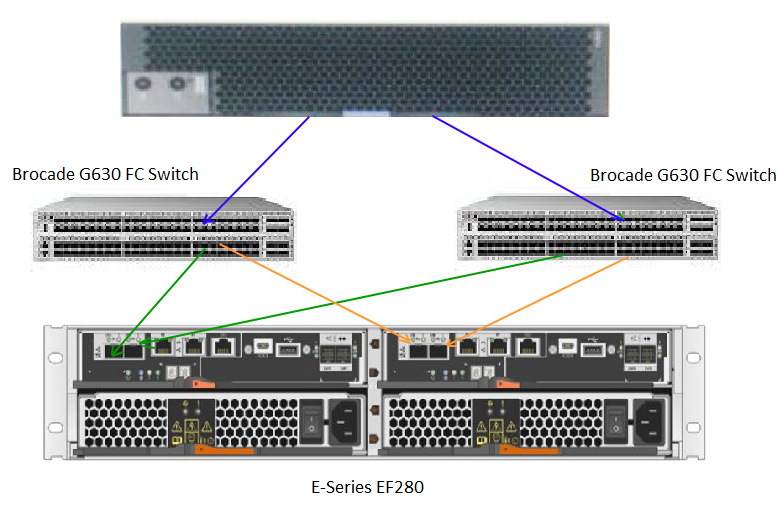Curious about Actual NetApp NCIE (NS0-516) Exam Questions?
Here are sample NetApp Certified Implementation Engineer - SAN Specialist, E-Series (NS0-516) Exam questions from real exam. You can get more NetApp NCIE (NS0-516) Exam premium practice questions at TestInsights.
To enable one-way authentication in a new iSCSI Linux implementation, which three modifications should you make in the /etc/iscsi/iscsid.conf file on the Linux host? (Choose three.)
Correct : A, B, C
Target username and password: These credentials are used by the initiator to authenticate to the target.
Initiator username and password: These credentials are used by the target to authenticate the initiator.
CHAP: Challenge-Handshake Authentication Protocol is used to set up the authentication mechanism.
Modifications in the /etc/iscsi/iscsid.conf file include setting the appropriate values for these parameters.
Reference: NetApp iSCSI Configuration Guide for Linux, which details the configuration of CHAP and other authentication methods.
Start a Discussions
Which two errors would fail a pre-upgrade health check? (Choose two.)
Correct : B, D
Understand Pre-Upgrade Health Check:
Purpose: The pre-upgrade health check is designed to ensure the system is in a stable state before proceeding with firmware or software upgrades. This helps to avoid disruptions and data loss.
Volumes on Non-Preferred Path (B):
Issue: If volumes are reported on a non-preferred path, it indicates that there might be a pathing issue or an imbalance in the I/O load.
Impact: Non-preferred paths can lead to performance degradation and increased latency, which might cause issues during the upgrade process.
Resolution: Ensure that all volumes are accessible through their preferred paths before initiating the upgrade.
I/O Being Processed (D):
Issue: Active I/O during the upgrade process can lead to incomplete or failed upgrades.
Impact: Processing I/O during an upgrade can result in data corruption or loss, and may also cause the upgrade to fail.
Resolution: Suspend or stop all I/O operations on the system before starting the upgrade.
NetApp E-Series Upgrade and Health Check Documentation
NetApp SANtricity System Manager User Guide
NetApp E-Series Upgrade Procedures and Best Practices
Start a Discussions
Where would you find the version of the driver and firmware for QLogic HBAs that are supported by NetApp E-Series systems?
Correct : A
Access the Interoperability Matrix Tool (IMT):
Step: Open the NetApp Interoperability Matrix Tool.
Reason: The IMT provides a comprehensive list of supported configurations, including specific versions of drivers and firmware for HBAs.
Navigate to HBA Compatibility:
Step: Search for QLogic HBA compatibility with NetApp E-Series systems.
Reason: To find the exact versions of drivers and firmware that are validated and supported.
Verify the Information:
Step: Cross-reference the information provided by the IMT with the installed hardware.
Reason: Ensuring compatibility to avoid issues related to unsupported configurations.
Start a Discussions
An orphaned volume occurs during an asynchronous mirror implementation. You must recover the orphaned volume.
In this scenario, which statement is correct?
Correct : A
Identify the Orphaned Volume:
Step: Use SANtricity System Manager to identify the orphaned volume.
Reason: To determine which volume has lost its mirror relationship.
Remove the Mirroring Relationship:
Step: Access the mirroring settings for the orphaned volume and remove the existing relationship.
Reason: The current relationship is invalid and needs to be removed to reset the configuration.
Re-create the Mirroring Relationship:
Step: Establish a new mirroring relationship for the previously orphaned volume.
Reason: To restore the asynchronous mirroring setup with a valid configuration.
NetApp SANtricity System Manager User Guide
NetApp Asynchronous Mirroring Best Practices Guide
Start a Discussions
Click the Exhibit button.

Referring to the exhibit, what is the total number of ALUA paths from the host to a volume on the EF280?
Correct : D
Understand ALUA Path Configuration:
Step: Review the exhibit to determine the paths between the host and the EF280.
Reason: ALUA (Asymmetric Logical Unit Access) provides multiple paths for redundancy and load balancing.
Count the Paths:
Observation: Each controller has two ports connected to two separate FC switches, and the host is connected to each switch, providing two paths per controller.
Calculation: 2 controllers x 2 paths per controller = 4 total ALUA paths.
NetApp EF280 System Documentation
NetApp ALUA Configuration Guide
Start a Discussions
Total 64 questions